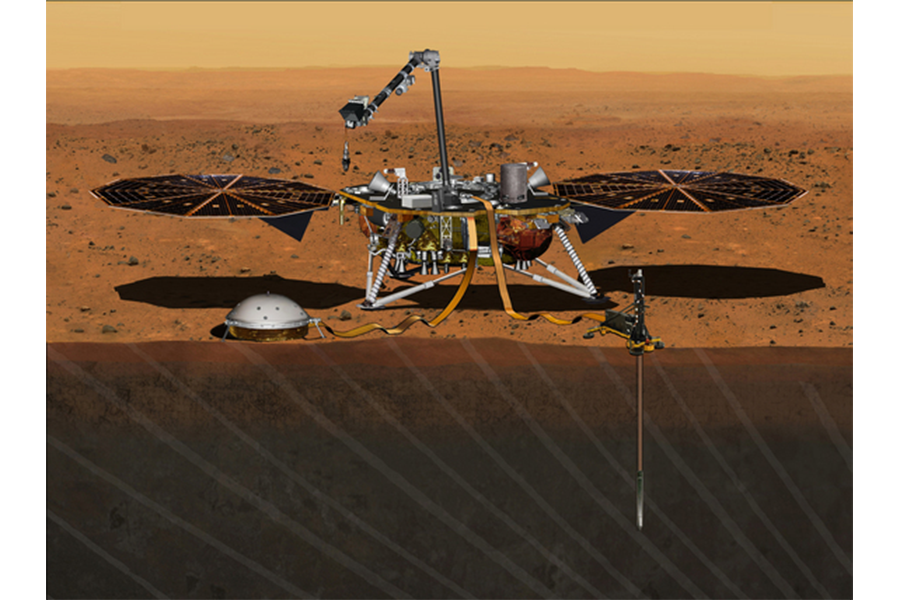Leaky seal postpones launch of NASA's next Mars lander
Loading...
NASA has called off the planned March 2016 launch of a Mars lander, saying one of the spacecraft's key instruments cannot be fixed in time for liftoff.
Because Mars and Earth align favorably just once every 26 months, NASA's InSight Mars lander now must wait until mid-2018 to begin its mission to characterize the Red Planet's interior in unprecedented detail — if the spacecraft gets off the ground at all. Indeed, there's a chance the mission will be scrapped entirely, agency officials said.
"That's all forward work," John Grunsfeld, associate administrator for NASA's Science Mission Directorate, said during a teleconference today (Dec. 22), referring to the determination of InSight's ultimate fate. "We just haven't had time to work through that because our focus was on getting ready to launch." [Photos: NASA's Mars InSight Mission to Probe Red Planet's Core ]
The problem lies with the Seismic Experiment for Interior Structure (SEIS), one of InSight's two primary science instruments. SEIS, which was provided by the French space agency CNES, is a suite of three seismometers designed to measure "Mars quakes" and other subsurface activity on the Red Planet.
SEIS requires a vacuum environment to make its ultraprecise measurements. NASA and CNES officials announced earlier this month that SEIS' vacuum container was leaking — an issue that was traced to a defective weld.
CNES President Jean-Yves Le Gall said two weeks ago that he expected the issue would be rectified in time for SEIS' shipment to the United States in early January. And the fixes indeed appeared to be working until Monday (Dec. 21), when a leak reappeared during testing at a facility in France, Grunsfeld said.
"As of yesterday, we were still planning to go," he said.
There simply is not enough time now to perform a lasting fix and to test that fix sufficiently before InSight's planned launch this March, he added.
"We're not ready to go," Grunsfeld said. "I think it's much better that we have this discussion now, rather than sending it to Mars and wishing we had the opportunity here on Earth to fix something."
Marc Pircher, director of CNES' Toulouse Space Center, expressed confidence that the SEIS issue will be resolved soon, since the problem lies in the spherical vacuum chamber and not with the nuts and bolts of the instrument itself.
"We are sure that we will fix the problem we have with the sphere in less than 26 months," he said during today's teleconference. "We will do that in a few months."
The total cost of InSight's mission — including launch, scientific operations and data analyses — is capped at $675 million, said Jim Green, head of NASA's Planetary Science division. So far, $525 million of that sum has been spent, he added.
NASA officials must now determine if the agency can still launch InSight in 2018 and stay under the $675 million cap. That work will begin soon, and will likely take a while, Grunsfeld said.
"Because of the alignment of the planets and the fact that it's 26 months off, we don't need to make an urgent decision in the next few weeks about whether to go for the next launch date or not," he said.
InSight, whose name is short for Interior Exploration using Seismic Investigations, Geodesy and Heat Transport, was designed to help scientists better understand Mars' interior structure — knowledge that, in turn, should shed light on the formation and evolution of rocky planets in general.
The lander's other main science instrument is the Heat Flow and Physical Properties Package (HP3), a heat probe designed to hammer itself up to 16 feet (5 meters) underground. Mission team members also plan to use InSight's communications gear to measure Mars' rotation very precisely; this information should reveal key insights about the Martian interior, including the size of the planet's core, team members have said.
InSight was scheduled to blast off atop a United Launch Alliance Atlas V rocket from California's Vandenberg Air Force Base on March 18. If and when InSight launches, it will become the first NASA planetary mission to do so from Vandenberg; such missions generally take off from Cape Canaveral Air Force Station in Florida.
Follow Mike Wall on Twitter @michaeldwall and Google+. Follow us @Spacedotcom, Facebook orGoogle+. Originally published on Space.com.
- How to Land on Mars: Martian Tech Explained (Infographic)
- What's Inside Mars? NASA's InSight Mission Will Probe Deep | Video
- 7 Biggest Mysteries of Mars
Copyright 2015 SPACE.com, a Purch company. All rights reserved. This material may not be published, broadcast, rewritten or redistributed.







